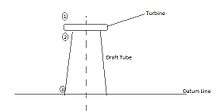Draft tube

In power turbines like reaction turbines, Kaplan turbines, or impulse turbines, a diffuser tube is installed at the exit of the runner, known as draft tube.[1] In an impulse turbine the available head is high and there is no significant effect on the efficiency if the turbine is placed a couple of meters above the tail race. But in the case of reaction turbines, if the net head is low and if the turbine is installed above the tail race, there can be appreciable loss in available pressure head. If the pressure at the exit of the turbine is lower than the pressure of fluid in the tail race, a back flow of liquid into the turbine can result in significant damage. By placing a diffusing pipe at the exit of the runner, the pressure head is increased by decreasing the exit velocity, and both the overall efficiency and the output of the turbine can be improved.
A draft tube at the end of the turbine increases the pressure of the exiting fluid at the expense of its velocity. This means that the turbine can reduce pressure to a higher extent without fear of back flow from tail race. The Draft tube gives an advantage of placing the turbine above the tail race so that any required inspections can be made easily. Moreover, it also converts the wasteful kinetic energy at the exit of the runner into the useful pressure energy.[2]
Efficiency

It is defined as the ratio of the actual conversion of kinetic energy into pressure energy in the draft tube to the kinetic energy available at the draft tube inlet
ɳ = Difference of kinetic energy between inlet and outlet-tube losses/Kinetic Energy at the inlet
ɳdt = :
V2 = Fluids velocity at inlet of draft tube or at the outlet of turbine
V3 = Fluids velocity at outlet of draft tube
g= gravitational acceleration
hd = head losses in draft tube
Draft Tube allows turbine to be placed above the tail race and simultaneously allows it to operate at the same efficiency if it was placed at the tail race[3]
Draft tube and cavitation
Cavitation occurs when the local absolute pressure falls below the saturated vapor pressure of the water for the water temperature.[4] The height of draft tube is an important parameter for avoiding cavitation. Applying Bernoulli's equation between outlet of the runner and discharge point of the draft tube Neglecting any head losses in draft tube)
z2 = z (Height of draft tube)
z3 = height of tail race which is referenced as datum line (=0)
p2 = pressure at the outlet of the runner
p3 = gauge pressure
since draft tube is a diffuser V3 is always less than V2 which implies p2 is always negative thus height of the draft tube is an important parameter to avoid cavitation.[5]
Types of draft tube
1. Conical diffuser or straight divergent tube-This type of draft tube consists of a conical diffuser with half angle generally less than equal to 10° to prevent flow separation. It is usually employed for low specific speed,vertical shaft francis turbine. Efficiency of this type of draft tube is 90%
2. Simple elbow type draft Tube-It consists of an extended elbow type tube. Generally, used when turbine has to be placed close to the tail-race. It helps to cut down the cost of excavation and the exit diameter should be as large as possible to recover kinetic energy at the outlet of runner. Efficiency of this kind of draft tube is less almost 60%
3. Elbow with varying cross section-It is similar to the Bent Draft tube except the bent part is of varying cross section with rectangular outlet.the horizontal portion of draft tube is generally inclined upwards to prevent entry of air from the exit end.[6]
References
- ↑ Elementary Draft Tube Theory (http://nptel.iitm.ac.in/courses/Webcourse-contents/IIT-KANPUR/machine/chapter_7/7_7.html)
- ↑ Valan Arasu A , “Turbo Machines”, Vikas Publishing House, Chapter 9, Page 402
- ↑ Valan Arasu A , “Turbo Machines”, Vikas Publishing House, Chapter 9, Page 403
- ↑ Ingram Grant, Basic Concepts in TurboMachinery, Chapter 9, Article 9.4.3
- ↑ Elementary Draft Tube Theory (http://nptel.iitm.ac.in/courses/Webcourse-contents/IIT-KANPUR/machine/chapter_7/7_7.html)
- ↑ Valan Arasu A , “Turbo Machines”, Vikas Publishing House, Chapter 9, Page 403